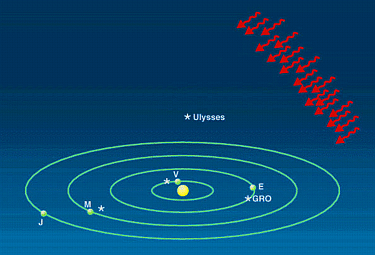
3.4 GAMMA-RAY BURST INSTRUMENTS
BATSE continues to operate, detecting approximately one burst per day and providing burst locations with several degree accuracy. At present, the only means of obtaining the arcminute-size GRB error boxes required for deep counterpart searches is triangulation with a network of widely separated detectors. The currently operating 3rd Interplanetary Network (IPN) consists of one distant spacecraft, Ulysses, and a cluster of near-Earth experiments, but primarily BATSE. The Russian Mars 96 would have completed the network, had it been launched successfully. Its failure means that the IPN will not be complete until 2001 at the earliest. Both BATSE and IPN burst locations are distributed rapidly to a wide community using the BATSE Coordinates Distribution Network (BACODINE). Follow-up searches for optical counterparts are carried out by several dedicated telescopes built to respond quickly and automatically to BACODINE triggers. A worldwide network of optical and radio observatories with sensitive telescopes also conducts counterpart searches based on both BATSE and COMPTEL burst locations relayed through New Mexico State University. Although these searches are not as prompt, they are much deeper. Soon HETE, the High Energy Transient Experiment, may be resurrected. The HETE X-ray camera can detect about 25 bursts per year and localize them to arcminute accuracy. Very small error boxes such as these, and indeed, much smaller ones, are required to perform the deepest possible counterpart searches without source confusion. CATSAT (Cooperative Astrophysical and Technology Satellite) is a small, inexpensive mission that will fly under the Student Explorer Demonstration Initiative program. It will measure the sub-keV emission of bursts to detect photoelectric absorption features, that could reveal the galactic or extragalactic nature of the sources, and the multi-keV spectra for cyclotron resonance features. In addition, an Earth albedo polarimeter will measure the X-ray polarization of bursts and thick scintillators will measure the MeV spectrum. CATSAT will be launched in early 1998 for a nominal, but extendible, one year mission. Depending on the triggering logic it will detect between 50 and 100 bursts per year. The controversy over whether gamma-ray burst spectra contain line components may be resolved by the Transient Gamma-Ray Spectrometer (TGRS) aboard NASA's Wind spacecraft. TGRS consists of a passively cooled Ge spectrometer covering the 20-8000 keV energy range with resolution 2.7 keV at 500 keV. If lines indeed exist as previously reported, they should be detected in strong bursts by this instrument.

Figure 3.2 - Ulysses/CGRO (IPN Network) in relation to the
solar system